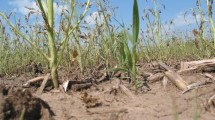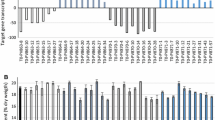Abstract
Done correctly, cellulosic bioenergy should be both environmentally and economically beneficial. Carbon sequestration and decreased fossil fuel use are both worthy goals in developing next-generation biofuels. We believe that biotechnology will be needed to significantly improve yield and digestibility of dedicated perennial herbaceous biomass feedstocks, such as switchgrass and Miscanthus, which are native to the US and China, respectively. This Forum discusses the sustainability of herbaceous feedstocks relative to the regulation of biotechnology with regards to likely genetically engineered traits. The Forum focuses on two prominent countries wishing to develop their bioeconomies: the US and China. These two countries also share a political desire and regulatory frameworks to enable the commercialization and wide release of transgenic feedstocks with appropriate and safe new genetics. In recent years, regulators in both countries perform regular inspections of transgenic field releases and seriously consider compliance issues, even though the US framework is considered to be more mature and stringent. Transgene flow continues to be a pertinent environmental and regulatory issue with regards to transgenic plants. This concern is largely driven by consumer issues and ecological uncertainties. Regulators are concerned about large-scale releases of transgenic crops that have sexually compatible crops or wild relatives that can stably harbor transgenes via hybridization and introgression. Therefore, prior to the commercialization or extensive field testing of transgenic bioenergy feedstocks, we recommend that mechanisms that ensure biocontainment of transgenes be instituted, especially for perennial grasses. A cautionary case study will be presented in which a plant’s biology and ecology conspired against regulatory constraints in a non-biomass crop perennial grass (creeping bentgrass, Agrostis stolonifera), in which biocontainment was not attained. Appropriate technologies that could be applied to perennial grass feedstocks for biocontainment are discussed.
Similar content being viewed by others
References
Al-Ahmad H, Galili S, Gressel J (2004) Tandem constructs to mitigate transgene persistence: tobacco as a model. Molecular Ecology 13:697–710
Al-Ahmad H, Dwyer J, Moloney M, Gressel J (2006) Mitigation of establishment of Brassica napus transgenes in volunteers using a tandem construct containing a selectively unfit gene. Plant Biotechnology Journal 4:7–21
Aylor DE (2002) Settling speed of corn (Zea mays) pollen. Aerosol Science 33:1601–1607
Burris JN, Mann DJG, Joyce BL, Stewart CN Jr (2009) An improved tissue culture system for embyrogenic callus production and plant regeneration in switchgrass (Panicum virgatum L.). BioEnergy Research 2:267–274
Chase CD (2006) Genetically engineered cytoplasmic male sterility. Trends in Plant Science 11:4–9
Clements DR, DiTommaso A, Jordan N, Booth BD, Cardina J, Doohan D, Mohler CL, Murphy SD, Swanton CJ (2004) Adaptability of plants invading North American cropland. Agriculture, Ecosystems and Environment 104:379–398
Daniell H (2002) Molecular strategies for gene containment in transgenic crops. Nature Biotechnology 20:581–586
Daniell H, Datta R, Varma S, Gray S, Lee SB (1998) Containment of herbicide resistance through genetic engineering of the chloroplast genome. Nature Biotechnology 16:345–348
Dohleman FG, Long SP (2009) More productive than maize in the midwest: how does Miscanthus do it? Plant Physiology 150:2104–2115
Ellstrand NC, Prentice HC, Hancock JF (1999) Gene flow and introgression from domestic plants into their wild relatives. Annual Review of Ecology and Systematics 30:539–563
Fernandez MGS, Becraft PW, Yin Y, Lubberstedt T (2009) From dwarves to giants? Plant height manipulation for biomass yield. Trends in Plant Science 14:454–461
Gressel J (2008) Transgenics are imperative for biofuel crops. Plant Science 174:246–263
Hagemann R (2004) The sexual inheritance of plant organelles. In: Molecular biology and biotechnology of plant organelles. Springer, Dordrecht, pp 93–114
Halfhill MD, Zhu B, Warwick SI, Raymer PL, Millwood RJ, Weissinger AK, Stewart CN Jr (2004) Hybridization and backcrossing between transgenic oilseed rape and two related weed species under field conditions. Environmental Biosafety Research 3:73–81
Halfhill MD, Sutherland JP, Moon HS, Poppy GM, Warwick SI, Rufty TW, Weissinger AK, Raymer PL, Stewart CN Jr (2005) Growth, productivity, and competitiveness of introgressed weedy Brassica rapa hybrids selected for the presence of Bt cry1Ac and gfp transgenes. Molecular Ecology 14:3177–3189
Hanson MR, Bentolila S (2004) Interactions of mitochondrial and nuclear genes that affect male gametophyte development. Plant Cell 16:S154–S169
Hird DL, Worrall D, Hodge R, Smartt S, Paul W, Scott R (1993) The anther-specific protein encoded by the Brassica napus and Arabidopsis thaliana A6 gene displays similarity to beta-1, 3-glucanases. Plant Journal 4:1023–1033
Iamtham S, Day A (2000) Removal of antibiotic resistance genes from transgenic tobacco plastids. Nature Biotechnology 18:1172–1176
Jacob K, Zhou F, Paterson AH (2009) Genetic improvement of C4 grasses as cellulosic biofuel feedstocks. In Vitro Cellular and Developmental Biology 45:291–305
Kausch AP, Hague J, Oliver M, Li Y, Daniell H, Maschia P, Watrud LS, Stewart CN Jr (2010) Transgenic biofuel feedstocks and strategies for bioconfinement. Biofuels 1:163–176
Koltunow AM, Truettner J, Cox KH, Wallroth M, Goldberg RB (1990) Different temporal and spatial gene expression patterns occur during anther development. Plant Cell 2:1201–1224
Konagaya K, Ando S, Kamachi S, Tsuda M, Tabei Y (2008) Efficient production of genetically engineered, male-sterile Arabidopsis thaliana using anther-specific promoters and genes derived from Brassica oleracea and B. rapa. Plant Cell Reports 27:1741–1754
Légère A (2005) Risks and consequences of gene flow from herbicide-resistant crops: canola (Brassica napus L) as a case study. Pest Management Science 61:292–300
Llewellyn D, Fitt G (1996) Pollen dispersal from two field trials of transgenic cotton in the Namoi Valley, Australia. Molecular Breeding 2:157–166
Lu B-R (2003) Transgene containment by molecular means–is it possible and cost effective? Environmental Biosafety Research 2:3–8
Luna VS, Figueroa MJ, Baltazar MB, Gomez LR, Townsend R, Schoper JB (2001) Maize pollen longevity and distance isolation requirements for effective pollen control. Crop Science 41:1551–1557
Luo K, Duan H, Zhao D, Zheng X, Deng W, Chen Y, Stewart CN Jr, McAvoy R, Jiang X, Wu Y, He A, Pei Y, Li Y (2007) ‘GM-gene-deletor’: fused loxP-FRT recognition sequences dramatically improve the efficiency of FLP or CRE recombinase on transgene excision from pollen and seed of tobacco plants. Plant Biotechnology Journal 5:263–274
Maliga P (2004) Plastid transformation in higher plants. Annual Review of Plant Biology 55:2289–2313
Mariani C, DeBeuckeleer M, Trueltner J, Leemans J, Goldberg RB (1990) Induction of male sterility in plants by a chimeric ribonuclease gene. Nature 347:737–741
McLaughlin SB, Kszos LA (2005) Development of switchgrass (Panicum virgatum) as a bioenergy feedstock in the United States. Biomass and Bioenergy 28:515–535
Messeguer J, Fogher C, Guiderdoni E, Marfa V, Catala MM, Baldi G, Mele E (2001) Field assessments of gene flow from transgenic to cultivated rice (Oryza sativa L.) using a herbicide resistance gene as tracer marker. Theoretical and Applied Genetics 103:1151–1159
Miller R, Keller M (2009) The DOE BioEnergy Science Center—a U.S. Department of Energy Bioenergy Research Center. In Vitro Cellular and Developmental Biology 45:193–198
Moon HS, Li Y, Stewart CN Jr (2010) Keeping the genie in the bottle: transgene biocontainment by excision in pollen. Trends in Biotechnology 28:3–8
Palmer PG (1974) A biosystematic study of the Panicum amarum-P. amarulum complex (Gramineae). Brittonia 27:142–150
Parrish DJ, Fike JH (2005) The biology and agronomy of switchgrass for biofuels. Critical Reviews in Plant Sciences 24:423–459
Richards HA, Rudas VA, Sun H, McDaniel JK, Tomaszewski Z, Conger BV (2001) Construction of a GFP-BAR plasmid and its use for switchgrass transformation. Plant Cell Reports 20:48–54
Rieger MA, Potter TD, Preston C, Powles SB (2001) Hybridisation between Brassica napus L. and Raphanus raphanistrum L. under agronomic field conditions. Theoretical and Applied Genetics 103:555–560
Rose CW, Millwood RJ, Moon HS, Rao MR, Halfhill MD, Raymer PL, Warwick SI, Al-Ahmad H, Gressel J, Stewart CN Jr (2009) Genetic load and transgenic mitigating genes in transgenic Brassica rapa (field mustard) × Brassica napus (oilseed rape) hybrid populations. BMC Biotechnology 9:93
Ruf S, Hermann M, Berger IF, Carrer H, Bock R (2001) Stable genetic transformation of tomato plastids-high-level foreign protein expression in fruits. Nature Biotechnology 19:870–875
Sainz M (2009) Commercial cellulosic ethanol: the role of plant-expressed enzymes. In Vitro Cellular and Developmental Biology 45:314–329
Sanderson MA, Reed RL, McLaughlin SB, Wullschleger SD, Conger BV, Parrish DJ, Wolf DD, Taliaferro C, Hopkins AA, Ocumpaugh WR, Hussey MA, Read JC, Tischler CR (1996) Switchgrass as a sustainable bioenergy crop. Bioresource Technology 56:83–93
Schnable PS, Wise RP (1994) Recovery of heritable, transposon-induced, mutant alleles of the rf 2 nuclear restorer of T-cytoplasm maize. Genetics 136:1171–1185
Simard M-J, Légère A (2004) Synchrony of flowering between canola and wild radish (Raphanus raphanistrum). Weed Science 52:905–912
Stewart CN Jr (2004) Genetically modified planet: environmental impacts of genetically engineered plants. Oxford University Press, New York, p 240
Stewart CN Jr (2007) Biofuels and biocontainment. Nature Biotechnology 25:283–284
Stewart CN Jr (2008) Pharming in crop communities. Nature Biotechnology 26:1222–1223
Stewart CN Jr, Halfhill MD, Warwick SI (2003) Transgene introgression from genetically modified crops to their wild relatives. Nature Reviews Genetics 4:806–817
Wang ZY, Lawrence R, Hopkins A, Bell J, Scott M (2004) Pollen-mediated transgene flow in the wind-pollinated grass species tall fescue (Festuca arundinacea Schreb.). Molecular Breeding 14:47–60
Wang D, Naidu SL, Portis SR Jr, Moose SP, Long SP (2008) Can the cold tolerance of C4 photosynthesis in Miscanthus x giganteus relative to Zea mays be explained by differences in activities and thermal properties of Rubisco? Journal of Experimental Botany 59:1779–1787
Wang F, Xiong X-R, Liu C-Z (2009) Biofuels in China: opportunities and challenges. In Vitro Cellular and Developmental Biology 45:342–349
Warwick SI, Stewart CN Jr (2005) Crops come from wild plants: how domestication, transgenes, and linkage effects shape ferality. In: Gressel J (ed) Crop ferality and volunteerism. CRC Press, Boca Raton, Florida, pp 9–30
Warwick SI, Simard MJ, Legere A, Beckie HJ, Braun L, Zhu B, Mason P, Seguin-Swartz G, Stewart CN Jr (2003) Hybridization between transgenic Brassica napus L. and its wild relatives: Brassica rapa L., Raphanus raphanistrum L., Sinapis arvensis L., and Erucastrum gallicum (Wild.) O.E. Schulz. Theoretical and Applied Genetics 107:528–539
Warwick SI, Légère A, Simard M-J, James T (2008) Do escaped transgenes persist in nature? The case of an herbicide resistance transgene in a weedy Brassica rapa population. Molecuar Ecology 17:1387–1395
Watrud LS, Lee EH, Fairbrother A, Burdick C, Reichman JR, Bollman M, Storm M, King G, van De Waters PK (2004) Evidence for landscape-level, pollen-mediated gene flow from genetically modified creeping bentgrass with CP4 EPSPS as a marker. Proceedings of the National Academy of Sciences of the United States of America 101:14533–14538
Wolt JD (2009) Advancing environmental risk assessment for transgenic biofeedstock crops. Biotechnology for Biofuels 2:27
Wolt JD, Kees P, Raybould A, Fitzpatrick JW, Burachik M, Gray A, Olin SS, Schiemann J, Sears M, Wu F (2009) Problem formulation in the environmental risk assessment for genetically modified plants. Transgenic Research 19:425–436
Wright LL (1994) Production technology status of woody and herbaceous crops. Biomass and Bioenergy 6:191–209
Yuan JS, Tiller KH, Al-Ahmad H, Stewart NR, Stewart CN Jr (2008) Plants to power: bioenergy to fuel the future. Trends in Plant Science 13:421–429
Zapiola ML, Campbell CK, Butler MD, Mallory-Smith CA (2008) Escape and establishment of transgenic glyphosate-resistant creeping bentgrass Agrostis stolonifera in Oregon, USA: a 4-year study. Journal of Applied Ecology 45:486–494
Acknowledgments
We appreciate the helpful comments of reviewers and editors, and our colleagues who have shaped our thinking about sustainability issues in bioenergy. We appreciate the support of the UT AgResearch and that of the BioEnergy Science Center to CNS. The BioEnergy Science Center is a U.S. Department of Energy Bioenergy Research Center supported by the Office of Biological and Environmental Research in the DOE Office of Science. The paper is also been enabled by a series of USDA Biotechnology Risk Assessment Grants to CNS through the years.
Author information
Authors and Affiliations
Corresponding author
Rights and permissions
About this article
Cite this article
Moon, H.S., Abercrombie, J.M., Kausch, A.P. et al. Sustainable Use of Biotechnology for Bioenergy Feedstocks. Environmental Management 46, 531–538 (2010). https://doi.org/10.1007/s00267-010-9503-5
Received:
Accepted:
Published:
Issue Date:
DOI: https://doi.org/10.1007/s00267-010-9503-5




